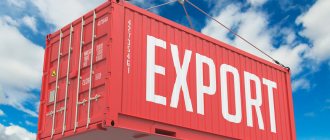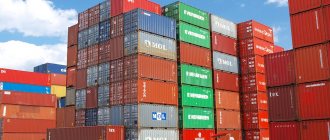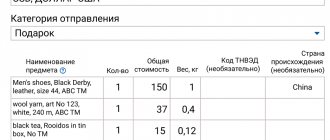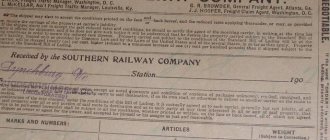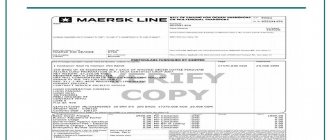One of the popular and profitable types of delivery of goods for foreign economic activity is sea transportation. Initially, during transportation by sea, a large amount of cargo did not reach the recipient - it was sold, pawned, etc. In order to protect the interests of the shipper, a special document was introduced in logistics - a bill of lading, which is still mandatory for presentation when carrying out maritime transport. Let's talk in more detail about what kind of paper this is, what its types and functions are, and we will also tell you how to properly draw up a bill of lading.
Bill of lading - what is it?
A bill of lading is a type of document of title used in foreign trade, certifying the existence of an agreement on the transportation of goods between the shipper and the carrier. To put it in simple words, what it is – essentially, it is an officially issued receipt. It is issued by a maritime transport company to the owner of the cargo indicating that the carrier has received the goods and undertakes to deliver it to the recipient.
A bill of lading is a document confirming the holder's right to dispose of the cargo. It is drawn up on a special form by the carrier and handed over to the shipper only after the goods have been shipped, that is, it is also a kind of acceptance certificate. The concept of a bill of lading, registration rules and details are reflected in the Russian Merchant Shipping Code.
Note! Previously, a bill of lading was used only for sea or river transportation of cargo; now this document is also issued for multimodal (several modes of transport) transportation. According to Article 143 of the Merchant Shipping Code of the Russian Federation (hereinafter referred to as the Code of Merchant Shipping of the Russian Federation), as a paper confirming receipt of goods by the carrier, it is allowed to use another document - a sea waybill - instead of a bill of lading.
Multimodal transport bill of lading and its features
A multimodal transport bill of lading is very similar to a sea bill of lading - except that it is used for transport only when at least two different modes of transport are envisaged.
It is worth noting that UCP 600, the new edition of the ICC rules for documentary credits, no longer contains a clause on “Multimodal Transport Documents”, but instead has a clause on “Transport Document Covering Transport by at least Two Different Modes of Transport”. Although a multimodal transport bill of lading also serves as a receipt for delivery of goods to the carrier, it does not necessarily indicate that the goods were loaded “on board” an ocean-going vessel. For example, a receipt may relate to the acceptance of a container at a container terminal.
Functions of a bill of lading
A bill of lading is a document that has a multi-purpose purpose, as it performs several functions.
- A certificate (receipt) that the carrier has received the cargo from the owner, with a description of the condition of the goods - quantity, presence or absence of external damage. In case of disputes, the bill of lading will serve as the evidence base. If the cargo is damaged, a note is made on the front side of the bill of lading.
- Confirmation of the fact of concluding a contract between the shipper and the transport company. The bill of lading itself cannot replace a contract, since the document is signed unilaterally by the carrier. However, the main terms of the contract are stated in it.
- Granting the right to dispose of transported cargo. In essence, a bill of lading is a negotiable document: it can be sold during transportation, transferred under certain conditions, or purchased. In this case, the new owner of the bill of lading will receive the cargo.
- Source of information about the transported goods. The document describes the quantity of cargo, the presence or absence of damage - for the transport company this is a good incentive to monitor transportation conditions. For example, if the consignee discovers packaging damaged during transportation, the latter has the right to demand compensation for damage.
- A shipping document on the basis of which the cargo is transferred to the recipient.
Need to know! Upon receipt of the cargo, the buyer must check it for integrity and safety. If this was not done, subsequent claims against the transport carrier will not be possible.
Why is a bill of lading a security?
The bill of lading confirms the presence of a consignment of insured cargo, which can be exhibited as a futures contract on one of the commodity and universal exchanges.
In fact, a bill of lading is a transport and commercial document that is issued to the sender by the carrier in several copies when accepting cargo for transportation. There are special forms for completing such documentation. They are developed by shipowner associations, liner shipping companies and other maritime enterprises. Most bills of lading are developed under the auspices of the international non-governmental maritime organization - the Baltic and International Maritime Council (BIMCO).
Types of bills of lading
In international trade practice, various types of bills of lading are used. The classification of varieties depends on the bearer of the document, the transportation route, the presence of marks regarding the condition of the cargo, the type of transportation, and the timing of delivery of the goods. We present the main types of bills of lading.
General division: negotiable and non-negotiable
All bills of lading are divided into two general types. The negotiable bill of lading is a security because it allows the owner to dispose of goods still in transit before arriving at the port. Such a bill of lading can be transferred to third parties - sold, bought and pledged to a bank, that is, the cargo along the route turns into an object of commodity-money turnover. This is where the name of the security comes from.
Much more often in practice, a non-negotiable bill of lading is used, which fixes the recipient of the goods immediately as the sole copyright holder of the cargo. It is not possible to transfer such a document to a third party. Non-negotiable bills of lading are registered due to the fact that the name of the recipient of the cargo is indicated in the document.
Warrant
The negotiable type includes to-order bill of lading. Such a document is drawn up if the shipper or recipient transfers the right to a third party to receive the cargo, and the owner may change more than once during the transit of the goods. On the back of the document form, an endorsement (endorsement) is affixed indicating the person to whom the right to receive the goods is transferred. Due to the fact that the owners of the cargo may change more than once during transportation, there may be several endorsements. The recipient will be the one whose name appears on the last entry.
Nominal
This type of security (straigth bill of lading) is issued exclusively to a specific legal entity or individual, and the exact delivery address of the goods is indicated here. Transfer of a registered bill of lading (and therefore the cargo) to another recipient is impossible.
To bearer
A bill of lading (bearer bill of landing), where the recipient's details are not indicated: the cargo will be issued at the port to the one who presents this document. In practice, such documents are used very rarely, since any person holding such paper is a legal consignee.
Important! Negotiable bills of lading - order bill of lading and to bearer - are beneficial if the buyer for some reason cannot pay for the goods. The execution of such documents allows the seller to transfer the cargo to another recipient.
Ocean
This type of bill of lading (Master Bill of Lading) is also called the main one. Such a document is issued by the shipping line carrying out the transportation. The original gives the right to receive the goods at the point of arrival. Using the ocean bill of lading number, you can track the movement of goods on the website of the shipping line-carrier.
Linear
The linear form (liner bill of lading) is used for regular maritime transport on ships that follow one established route and a constant schedule, stopping at certain ports. The bill of lading indicates that the goods have been accepted on board; the carrier is responsible for the goods from the moment of loading until delivery to the recipient.
Home
A home bill of lading is issued in order to avoid problems associated with the transportation of goods. The main reasons for compiling this document:
- the need to hide information about the recipient and the cargo transportation route;
- provision by the sender or carrier of services not related to the field of maritime logistics;
- the charterer does not want to disclose the owner of the transport to the client;
- The bill of lading must be issued before the time of shipment.
Charter (or freight)
A chartered bill of lading is issued if the goods are transported on the basis of a charter agreement (the ship is hired for a certain period of time or voyage). The charterer provides the charterer with a vessel or part thereof for cargo. A charter bill of lading is reserved for non-scheduled operations and is not considered to form the basis for a contract of carriage by sea.
Straight
This type of bill of lading is used for direct transportation - from one point to the final point, without transshipment at other ports.
End-to-end/multimodal
A through bill of lading or multimodal transport bill of lading is drawn up if the transportation is multimodal - moving cargo on several ships or using other modes of transport (road or rail). It is more convenient to use such a document than to draw up separate contracts with each transporter at all stages. Delivery of the cargo is considered completed when the last carrier has handed it over to the recipient.
Feeder
If the goods are not transported by a direct route, but through an intermediate port with a change of vessel, a short bill of lading is issued. This is possible, for example, if the ships of the transport company are not operating at the port of shipment of the goods. During loading on the other side, the local carrier issues a separate feeder document.
Attention! The feeder type is not a document of title, it only acts as a contract between the main transporter and the intermediate one. The bill of lading must be presented at the customs control point due to the fact that the latter will require transport documents for the part of the route where the border was crossed.
Clean
Typically, a clean bill of lading indicates that the goods are in satisfactory condition, and there are no marks or reservations about defects in the cargo or damage to the packaging.
"Unclean" (with reservations)
This type of bill of lading (claused bill of lading) contains entries (disclaimers) on the reverse side of the form about damage to the container, visible defects of the goods, non-compliance of the cargo with the description, etc. Such paper will be accepted by the bank, provided that the specified notes or reservations are permissible under the agreement for payment.
Important! When inspecting the cargo, the captain may record comments on the bill of lading. By signing the document, the representative of the transport company undertakes to deliver the cargo to the recipient in the condition and quantity specified in the bill of lading. If the carrier has not made a note about the external condition (damage) of the cargo, then it is considered good. Therefore, the burden of proof in possible disputes will then fall on him!
Bill of lading for loading and on board
If the goods have already been handed over to the carrier, but have not yet been placed on transport, a bill of lading is drawn up for loading (received for shipment). An on-board bill of lading (shipped) certifies the fact of loading of goods onto a ship; it is issued when the products are already on board.
Coastal
After acceptance of the goods from the shipper, but even before loading onto the ship, a coastal (custody bill of lading) type of bill of lading is issued. At this time, the cargo is usually in the transporter's warehouse. After moving on board, a loading note is made in the paper; sometimes the shore bill of lading can be replaced with an on-board bill of lading.
Team (group)
This type of document (combined/ collapsible bill of lading) is issued for several cargoes intended for different recipients.
If an insurance policy is added to a document, it may be referred to as insured. Typically, products transported in containers are insured. In this case, the bill of lading will act as a document of title and as proof that the cargo is insured.
It must be remembered that receipt of the cargo is possible only upon presentation of the original bill of lading. However, when sending by post, there may be a delay or loss of the security. An alternative is to use the telex release service. After the goods have been shipped and the bill of lading has been issued, the original is presented to the shipping company, which, after checking the data, gives permission to its representatives at the port of destination to release the goods to the recipient. A stamp is placed on the bill of lading, which means that the document has been delivered (surrendered Bill of Lading).
What is the standard for drafting a bill of lading?
The bill of lading must be prepared in accordance with the provisions of Article 14 of UCP 600, which deals with document inspection standards.
The said article says:
“The description of goods, services or works, if contained in documents other than a commercial invoice, may be given in general terms consistent with their description in the letter of credit.”
That is, the description of the goods in the bill of lading and the description in the letter of credit may be textually different, not identical, but identical in essence.
The same article states that:
“...if the addresses of the beneficiary and the applicant are contained in any specified document of credit, they need not be the same as those shown in the letter of credit or in any other specified document, but must be in the same country as the corresponding addresses mentioned in letter of credit. Contact details (telefax, telephone, email address, etc.) indicated as part of the address of the beneficiary and applicant will not be taken into account.”
Article 14k provides that “... the shipper or consignor of the goods named in any document need not be the beneficiary of the letter of credit,” which obviously applies to the bill of lading.
It is also worth keeping in mind that the date of the bill of lading may precede the date of issue of the letter of credit, but should not be later than the date of its presentation.
Signs of a correctly drawn up bill of lading:
- The bill of lading is not necessarily issued by the carrier or master. If the letter of credit allows a bill of lading issued by a forwarder or with the condition “domestic (domestic) bill of lading is allowed”, etc., the signature on the transport document affixed by the person who issued it may not indicate “in what capacity this person signed” , nor the name of the carrier.
- The statement “forwarder-issued bill of lading is not permitted” or “domestic bill of lading is not permitted” is meaningless unless the letter of credit specifically requires the company from which it must be issued or signed. If there is an indication “forwarder-issued bill of lading is not permitted,” financial institutions must accept a transport document signed “as a carrier,” without regard to the actual competence of the person issuing the document.
- The bill of lading must be signed in accordance with the requirements of Article 20 of UCP 600. If the document is signed by an agent, he must be named as “agent on behalf of (name of) carrier”, “agent on behalf of (name of) carrier”, etc.
- The phrases "loaded in good condition", "loaded on board", "clean on board" or other expressions containing the words "shipped" or "on board" have the same meaning as "loaded on board", are identical.
- The name of the port of destination must be indicated in the column marked “Port of Discharge”. The name of the destination port may also be contained in the “Destination” column (or other similar column), provided that the destination port is the same as indicated in the “Destination” field.
The bill of lading must also contain a side note consisting of at least four paragraphs:
- an indication of the goods being placed on board;
- full name of the vessel according to registration documents;
- place of delivery;
- delivery date of shipment.
But there is no constant need for an on-board marking, i.e. it may not be needed. UCP 600 contains a list of situations when side marking is necessary, these include cases when:
- the bill of lading does not contain information about the vessel, it is stated as “indicative, possible”. In this case, the side note must contain the name of the vessel;
- the bill of lading does not contain information about the port of loading, it is indicated as “indicative, possible”.
One of the popular legal ways to avoid making a side note is to cross out the words “indicative, possible” and certify the authenticity of this strikethrough by the parties.
If the port of loading named in the letter of credit is shown as the place of receipt of the cargo (in which case the fields intended to indicate the ocean vessel and port of loading contain details of the transhipment) for transport by sea from the port, then a dated on-board notation is required. It reflects the port of loading specified in the letter of credit and the ship that departs from this port.
The bill of lading can be drawn up in several original copies, but it should not contain a note that the delivery of the goods is possible only if all originals are provided. The main original is the accompanying (accompanying the goods) bill of lading.
If the letter of credit does not specify the notified party, the bill of lading may indicate the details of any notified party. In this case, if the applicant’s details are indicated, these data should not contradict the corresponding data in the letter of credit.
Correction of data, crossing out and underlining in the bill of lading are permitted, but must be certified by the parties.
Of course, this is a short essay on the bill of lading; readers can find a lot of interesting things if they turn to the primary sources - the above-mentioned international acts.
Procedure for working with a bill of lading
Before the work on drawing up the bill of lading begins, the shipper (or his authorized representative) draws up a loading order in several copies, which includes data on the goods being transported:
- name of the vessel;
- name of the product, marking of the cargo, its quantity;
- type of packaging;
- data (names and addresses) of the shipper and recipient);
- information about ports of loading and delivery.
After the goods are shipped, the captain signs the document, and one of the copies of the order becomes the navigator’s receipt, which confirms the fact of loading the products onto the ship. The bill of lading is issued to the shipper in exchange for a receipt.
Attention! A bill of lading is usually drawn up in a set of three copies, with completely identical contents. One copy is given to the sender, the other is for the carrier, and the last one is sent to the recipient of the cargo. When the goods are delivered, the carrier transfers them to the recipient in exchange for a bill of lading - only the original. After this, the remaining copies lose their legal force.
Telex release instead of bill of lading
When it is impossible to obtain a bill of lading in the usual way, a telex release is issued. This is an internal document of the shipowner. It gives the carrier the right to load and deliver the goods without a bill of lading. The telex release is transmitted via the carrier’s internal communication channels. The basis is to receive the original copy of the bill of lading.
THIS IS INTERESTING. Telex release is most often issued when an advance payment has been made for the cargo, but the bill of lading is held as collateral by the sender until 100% of payment is received.
Filling out a bill of lading - how to do everything according to the rules
To prepare the document, special letterheads are used (below you can see what the document looks like). The details are entered by printing in the appropriate columns intended for them. All information - characteristics of the cargo, information about the parties to the contract, the date of delivery - must be completely identical to the data specified in the other documents. The person who draws up the bill of lading must know how to fill it out correctly and take into account the following:
- any errors in filling may cause delays in delivery of cargo;
- all mandatory details and the location of each of them, regardless of the route of the goods and the carrier, remain unchanged;
- the shipper can be both the manufacturer and the seller of the goods;
- if the cargo has specific characteristics (value, fragility, danger, etc.), this must be indicated in the bill of lading;
- each copy is assigned an original number to identify it;
- some columns of the document may not be filled in if they do not play a role for the specific goods being transported or the conditions of transportation;
- each copy bears the inscription “ORIGINAL”, and copies of the document bear the inscription o.
It is important to know! Corrections to the bill of lading are permitted only with the consent of the shipper. At the same time, making adjustments will take a lot of extra time and entail additional costs.
Filling rules
To avoid possible problems, you must follow the rules for filling out the bill of lading. If it is filled out with errors or inaccuracies, this will seriously complicate the process of customs clearance and shipment of goods.
To fill out the bill of lading, the sender of the goods must provide the following data:
- The legal name of the transport company that has been approved as the cargo carrier;
- The name of the transport vessel, if the cargo was accepted not by a shipping company, but by a specific ship;
- Legal name of the supplier's company;
- Name of the terminal where the cargo was processed and subsequently transferred for loading;
- Name of arrival terminal;
- The name of the person who will receive the goods at the destination;
- Full name of the supplied products;
- Technical information about the product (size, weight, quantity);
- Freight paid;
- Invoices confirming payment for carrier services;
- Number of original copies of signed documents;
- Signature of the ship's captain or owner of the vessel. In some cases, the signature of an authorized representative of the transport company is allowed.
To avoid difficulties, you can use a sample bill of lading, with which even a beginner will be able to draw up the form. Well, it is issued as a standard document or letterhead of an approved freight forwarding company.
The main document is the accompanying copy of the bill of lading. Its remaining copies differ in color and are recognized only as copies. In order to identify each of the copies, serial numbers may be indicated on them.
What are the consequences of an incorrectly completed bill of lading?
Correctly filling out a bill of lading is not an easy task. In order to avoid problems, you need to treat the process carefully and responsibly. Filling out the document incorrectly can lead to serious consequences:
- delay in customs clearance of cargo;
- excessive financial costs for data correction;
- delays in unloading goods at the port of destination;
- payment of compensation to the vessel for demurrage due to delay;
- the product may become unusable.
Invoice and non-negotiable bill of lading
A consignment of goods shipped under a registered bill of lading is intended for a specific person, usually the importer.
The consignee does not need such a bill of lading to receive delivery. It will be enough to provide “credentials”. If the selection of a consignee is made irrevocably before the importer makes payment or accepts an obligation to pay, the consignor has the right to change the consignee at any time. For this reason, in documentary sales, a registered bill of lading does not provide banks with the same guarantee that an order bill of lading does. Registered bills of lading can be used when the exporter is confident that the importer will make payment, as in the case of an open account payment, or when the importer has already made payment, as in the case of an advance payment. Another option for a non-negotiable bill of lading is the sea waybill. The sea waybill (which goes by a number of different names, such as freight receipt) serves as evidence of the contract of carriage and as a receipt for acceptance of the cargo, but is not a document of title. Therefore, it should not be used when the importer wishes to sell the goods in transit or when the bank requires a transport document as security. A sea waybill may have the advantage of not requiring the original to accept delivery. This is convenient when there is a possibility of the goods arriving at the destination port before the arrival of the relevant documents, which is often the case in international trade, especially on short ocean routes.
For air transport, the transport document is the air waybill (or “AWB”), the typical form of which is the IATA (International Air Transport Association) air waybill. An air waybill is often issued by freight forwarders acting as agents for the air carrier. Typically, the seller selects such a freight forwarder and instructs him to clear goods for export through customs. Air waybills issued by freight forwarders are known as air waybills brokered (HAWB), while air waybills themselves (MAWB).
For rail transport, the transport document is the railway bill of lading. In Europe, this document is regulated by the CIM Convention (International Convention for the Carriage of Goods by Rail).
For road transport, a road consignment note is used, regulated in Europe by the CMR Convention (International Convention on the Carriage of Goods by Road).
- International air transportation. Nuances of the process that are worth knowing in advance
Samples of bills of lading
Here are examples of filling out bill of lading forms in Russian and English, which you can download.
- Sample of filling out a bill of lading in Russian
- Bill of lading form in English
Extensive experience in the field of foreign trade activities, thorough knowledge of customs legislation give us the right to assert: your cargo will be processed and delivered within the agreed time frame and without unnecessary financial expenses.
The world's largest commodity exchanges for trading bills of lading
| State | Exchange | National currency | Financial regulator |
| North America | |||
| USA | ICE (Intercontinental Exchange, theice.com), CME (Chicago Mercantile Exchange, cmegroup.com), CBOT (Chicago Board of Trade, cmegroup.com/company/cbot.html), COMEX (Commodity Exchange, part of NYMEX, cmegroup.com/ company/comex.html), Minneapolis Grain Exchange (MGEX, mgex.com), NADEX (binary options exchange, nadex.com), NYMEX (New York Mercantile Exchange, cmegroup.com/company/nymex.html) | USD | NFA, CFTC, SEC |
| South America | |||
| Argentina | Rosario Futures Exchange ROFEX (rofex.com.ar), Buenos Aires Futures Exchange MATBA (matba.com.ar) | A.R.S. | CNV |
| Asia | |||
| Malaysia | KLSE (Kuala Lumpur Futures Exchange, bursamalaysia.com) | MYR | Labuan FSA |
| Singapore | SGX (Singapore Exchange, sgx.com) | SGD | M.A.S. |
| India | MCX (mcxindia.com), NCDEX (ncdex.com) | INR | SEBI |
| China | Dalian Commodity Exchange (dce.com.cn), Zhengzhou Commodity Exchange (CZCE, english.czce.com.cn), HKE (hkex.com.hk) | CNY | CSRC |
| Taiwan | TWSE (Taiwan Stock Exchange, twse.com.tw) | TWD | CSRC |
| Türkiye | BIST (Borsa Istanbul, borsaistanbul.com) | TRY | C.M.B. |
| UAE | Dubai Gold and Commodity Exchange (DGCX, dgcx.ae), Dubai DME Exchange (dubaimerc.com) | AED | Dubai FSA |
| Japan | Tokyo Commodity Exchange (TOCOM, tocom.or.jp), Osaka Dojima Commodity Exchange (ODE, osaka-dojima.org) | JPY | JSDA |
| Europe | |||
| Russia | MOEX (Moscow Exchange, moex.com), St. Petersburg International Commodity Exchange (spimex.com), JSC National Commodity Exchange (namex.org), FORTS (Moscow Exchange derivatives market, moex.com/s96) | RUB | Bank of Russia |
| Great Britain | LME (London Metal Exchange, lme.com), LIFFE (London Futures Exchange, theice.com/futures-europe) | GBP | FCA |
| Oceania | |||
| Australia | ASX (Australian Securities Exchange, asx.com.au) | AUD | ASIC |
| Africa | |||
| South Africa | Safex (South African Futures Exchange, jse.co.za/trade/derivative-market/commodity-derivatives) | ZAR | FSCA |
| Ethiopia | Ethiopian Commodity Exchange (ECX, ecx.com.et) | ETB | National Bank of Ethiopia |
